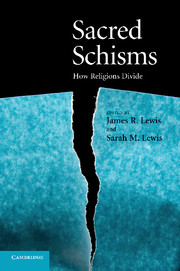Book contents
- Frontmatter
- Contents
- List of figures
- Notes on contributors
- Acknowledgments
- Introduction
- PART I THEORETICAL OVERVIEW
- PART II SURVEY OF SCHISMS IN SELECTED TRADITIONS
- PART III CHRISTIAN TRADITIONS
- PART IV WESTERN ESOTERIC TRADITIONS
- 8 Church Universal and Triumphant: shelter, succession and schism
- 9 Schism and consolidation: the case of the theosophical movement
- 10 Satanists and nuts: the role of schisms in modern Satanism
- 11 Schism as midwife: how conflict aided the birth of a contemporary Pagan community
- PART V NON-WESTERN/POSTCOLONIAL TRADITIONS
- Index
- References
10 - Satanists and nuts: the role of schisms in modern Satanism
Published online by Cambridge University Press: 24 October 2009
- Frontmatter
- Contents
- List of figures
- Notes on contributors
- Acknowledgments
- Introduction
- PART I THEORETICAL OVERVIEW
- PART II SURVEY OF SCHISMS IN SELECTED TRADITIONS
- PART III CHRISTIAN TRADITIONS
- PART IV WESTERN ESOTERIC TRADITIONS
- 8 Church Universal and Triumphant: shelter, succession and schism
- 9 Schism and consolidation: the case of the theosophical movement
- 10 Satanists and nuts: the role of schisms in modern Satanism
- 11 Schism as midwife: how conflict aided the birth of a contemporary Pagan community
- PART V NON-WESTERN/POSTCOLONIAL TRADITIONS
- Index
- References
Summary
There are no categories of Satanists – there are Satanists and nuts. The Satanic know-it-alls try to fabricate a division.
Anton Szandor LaVey in Barton 1990: 70Satanism – to many Western readers the connotations of the term bring to mind strife, hate, division and opposition. In a sense, this worldview must be the ultimate schism as it breaks away from all that is considered good, beautiful and just in Christian society. After all, “Satan” is the opposition, the accuser and later adversary to God. The dark-robed raving cultist or the suave, often British, but fundamentally evil gentleman are both typical stereotypes of the Satanist of popular culture, sadly brought to life by the moral panics of the Satanism Scare in the 1980s and 1990s that falsely attributed these fictional characters to real life. Even though it would be an important study, I will not attempt to write the history of Satanism as a schismatic movement within Christianity or the use of the allegation “Satanist” in medieval or modern-day religious hysteria. In fact, I consider these interpretations of Satanism to be a subcategory of either theology or the sociology of moral panics and not a critical study of modern religion. There are other real-life Satanists, answering proudly to the term and fighting for their freedom of thought and expression. It is to these individuals and their disagreements we now turn.
- Type
- Chapter
- Information
- Sacred SchismsHow Religions Divide, pp. 218 - 247Publisher: Cambridge University PressPrint publication year: 2009
References
- 6
- Cited by



